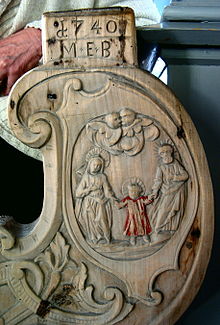Melchior Eberhard
Melchior Eberhard (born November 6, 1701 in Hindelang , † 1777 in Hindelang) was a German baroque sculptor. His son Johann Richard Eberhard also became a sculptor (probably apprenticed to his father). He surpassed his father in ability and reputation. From the two grandchildren, Franz Xaver Eberhard and Konrad Eberhard , sculptor and painter, Konrad gained national importance and fame.
Life
Little is known about Melchior Eberhard's family circumstances. His father was a “linen weaver, born in the Beilenberg parish of Altstädt”. In the distant St. Florian monastery near Linz , the boy from Hindelang was trained as a sculptor by Leonhard Sattler . Sattler was a compatriot and came from old towns . Melchior's apprenticeship began in 1717, and in 1723 he returned home from abroad with two journeymen from Sonthofen . Possibly he worked for a while at Anton Sturm in Füssen before setting up his own workshop in Hindelang. In any case, Melchior Eberhard didn't get married until December 16, 1738. His wife, Afra Mayer, came from Leeder . After his marriage in 1766 at the latest, his son Johann Richard Eberhard took over the workshop, although it can be assumed that Melchior Eberhard continued to work as an employee until his death.
plant
Melchior Eberhard's work has not yet been adequately researched. His work can mainly be found scattered in the southern Allgäu , although it seems that he was denied significant commissions. The most extensive work is 14 statues - the twelve apostles with Paul and Mary - for the parish church of St. Verena in Fischen im Allgäu . In the chord of March 29, 1759, Eberhard is referred to as a “kunsterfarner” sculptor. He received the considerable sum of 100 guilders for his work, and his son Johann Richard also received a “tip” of 4 guilders 49 Kreuzer. Melchior Eberhard received excellent technical training “according to the latest style” from Sattler. Christian Arnold attests to him an as yet unused, fresh plastic nature in keeping with the Baroque and Rococo, an original strength of his imagination of form and an impulsive, spirited movement of his bodies and clothes.
Individual evidence
- ↑ Michael Petzet: Die Kunstdenkmäler von Schwaben VIII, Landkreis Sonthofen, Munich 1964, p. 259.
literature
- Christian Arnold: Konrad Eberhard 1768-1859, sculptor and painter. Life and works of an Allgäu artist family , publications by the Swabian Research Association at the Commission for Bavarian State History, Series 1, Studies on the History of Bavarian Swabia, Vol. 8, Augsburg 1964.
- Herbert Wittmann: The Hindelang sculptor Johann Richard Eberhard (1739-1813) and his workshop , in: Extra Verren 2012, Yearbook of the Museum Association of the Reutte District , pp. 67–150.
| personal data | |
|---|---|
| SURNAME | Eberhard, Melchior |
| BRIEF DESCRIPTION | German baroque sculptor |
| DATE OF BIRTH | November 6, 1701 |
| PLACE OF BIRTH | Hindelang |
| DATE OF DEATH | 1777 |
| Place of death | Hindelang |


